I am in the process of re-reading Simon Barnes’s delightful book, “How to Be a (Bad) Birdwatcher,” which I discovered a couple of years ago at a local bookstore when I was looking for something else. (I love Amazon, but despite its best efforts to recommend things to me, there is still nothing like browsing the shelves of a bookstore and discovering something quite unexpected.)
In his book, Mr. Barnes lovingly writes of his nearly lifelong fascination with birds, and he good-naturedly scoffs at the competitive “collectors” who are the official “good” birdwatchers.
The Habit of Looking
He writes early on, “Birds are in our past; they are in our blood and in our bones. In short, when you make the decision to become a bad birdwatcher, you do not start from scratch. You are already a bad birdwatcher. The baddest birdwatcher on the planet starts off with a huge bank of information, tradition and culture. After that, it is just a matter of getting the habit. The habit of looking.” (emphasis mine)
I am a (bad) birdwatcher. I don’t remember how it started. I vaguely remember being aware of a few birds as a child – robins, which I think we had all year in Seattle (Seattle having a mild climate, at least in those days), blue jays (which I later learned were Steller’s Jays), seagulls, pigeons, and crows, as well as a few notables such as something we called snowbirds (known as such because they occasionally appeared in the winter) and the highly unusual owl.
I moved to San Francisco as a young adult and I remember nothing of note about birds (other than hearing my first mourning dove and thinking it was an owl).
It wasn’t until I moved to rural Washington State in my mid-twenties that I began paying attention to birds. I hung my first bird feeder, but I don’t remember what visited it. I do remember sitting on my back deck, surrounded by woods on three sides, and being amazed by the depth of birdsong around me. I would close my eyes and try to count the many layers of birdsong – and would quickly get lost.
I think that is when the habit got me and I started noticing – and then looking for – birds. I saw my first bald eagle there, and that was an amazing sight.
We moved to Maine, and I discovered cardinals. And house finches. Both of which caught me in late winter with their calls – and their redness.
One day in late winter, when there was still snow on the ground and the only colors in the world were black, white and brown, I heard a loud bird call. It was a long, shrill, descending call. Over and over. What the heck was that? I followed my ears, and ended up staggering through the deep snow in my neighbor’s back yard until my eyes and ears located a spot of ruby red in a brown, leafless tree: Cardinal. He burned a spot in my mind with his fire. And I have been smitten ever since. We don’t have cardinals on the west coast, and I miss them.
Another day in Maine, this time in early, early spring when there was still a lot of snow on the ground but the gutters were running with snowmelt, I was walking into a building downtown and a magical trilling like the water burbling everywhere echoed around the granite entryway. What? I stopped short, and the man behind me walked into me. I couldn’t go in until I found it – a brown little bird with a red head and breast up in the archway, singing his lungs out. “Spring is coming! Spring is coming!” Despair at six months of wearing gloves and boots suddenly disappeared.
I later looked him up in my bird book, and there he was: A house finch. (Or a purple finch. But purple finches aren’t purple… what’s up with that? Anyway.) We have house finches on the west coast, too, and that makes me happy.
Also in Maine, I saw another bird I had never seen before. I described it to my husband’s aunt, who was nearly blind at the time. She thought about it for a minute, and then said, “It sounds like a flicker.” A what? But I looked it up, and she was right. Aunt Norma was a (bad) birdwatcher, too!
As time went by, my fascination expanded and, as we moved around the country, I was exposed to a variety of birds. I saw nuthatches, rose breasted grosbeaks, goldfinches that looked like dandelions on the lawn, herons, egrets, pelicans, red-winged blackbirds. Cedar waxwings that were smaller than I expected. Pheasant that sounded like a squeaky car door. Wild turkeys. More bald eagles. Ducks that nested in trees. White crowned sparrows, ruby-crowned kinglets, phoebes, various hawks, turkey vultures, and kingfishers. It’s a glorious birdworld, although I miss some of my friends from other areas (especially cardinals).
All of this came flooding through my mind, in less time than it took to write it (or read it), as I started to re-read Simon Barnes. I am most definitely a (bad) birdwatcher, and I’ve got it bad, too. But I don’t mind.
The Point
What was it that made me traipse through Mr. Brown’s snowy yard to see that cardinal? Wonder. Just as it was Wonder that once made me photograph a bowl of cherry tomatoes (Remember to Look Up, “Appreciate Beauty”). A cherry tomato is not a bird, but wonder is wonder. Wonder that something so simple can be so beautiful. And that is all that needs to be said.
Wonder. And Curiosity.
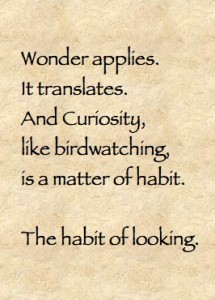 Except that is not all I will say. Wonder applies. It translates. And Curiosity, like birdwatching, is a matter of habit. The habit of looking. A habit that can be cultivated.
Except that is not all I will say. Wonder applies. It translates. And Curiosity, like birdwatching, is a matter of habit. The habit of looking. A habit that can be cultivated.
What are you curious about? What would happen if you cultivated curiosity about… people who are different? Or who don’t agree with you? What would happen if you wondered what would happen if…
How would your life be different if you got in the habit of noticing things? (Or, for the advanced among you, how has your life been transformed because you do notice things?
Here is what Simon Barnes says about birdwatching at its best: It is “not the chasing of the rare but the untroubled contemplation of the special.”
I get goosebumps when I read that.
And here’s the thing: It doesn’t just apply to birdwatching. It applies to all sorts of things. Not just birds.
What is special in your life? Is it a finite list? Or does it continue to grow?
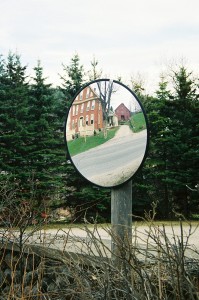
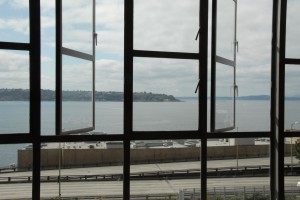
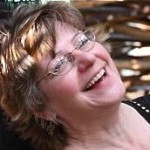
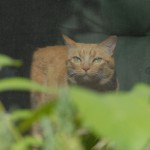
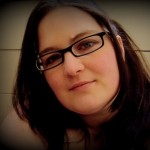
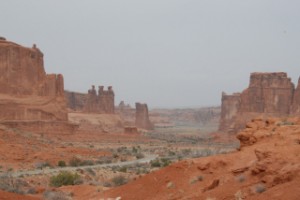
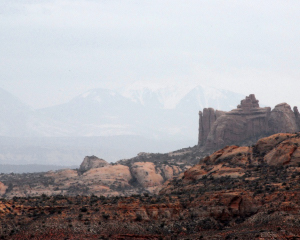



 Twitter
Twitter LinkedIn
LinkedIn Facebook
Facebook